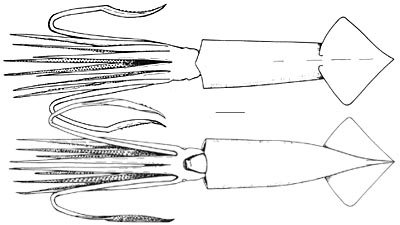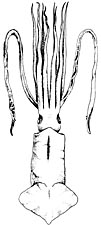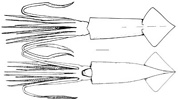Kondakovia
Kondakovia longimana
Michael Vecchione, Richard E. Young, and Kotaro TsuchiyaIntroduction
Kondakovia longimana is a large squid (adults to 740 mm ML) of the Southern Ocean (Kubodera, et al., 1998). The primary feature that sets this genus apart from similar species in Onykia is the presence of marginal sucker series on the tentacular clubs in subadults. The three squid of the type series were taken from the surface and at a depth of 50 m. All three had been feeding heavily on euphausiids (i.e. Euphausia superba). Clarke (1980) examined the stomachs of 7 squid and found remains of fish, crustacea, squid and sponges.
Diagnosis
An onychoteuthid ...
- with marginal suckers throughout club in subadults (unique character).
- without gladius visible beneath skin in dorsal midline.
- with 3 occipital folds.
Characteristics
- Tentacles
- Tentacular club with about 33 hooks and 33 small, marginal suckers.
 image info
image info
 image info
image infoFigure. Tentacular clubs of K. longimana. Top - Dorsal view, preserved, 195 mm ML, ELTANIN sta. 1392, NMNH specimen. Photograph by R. Young. Bottom - Oral view of tentacular club. Drawing from Filippova, 1972.
- Tentacular club with about 33 hooks and 33 small, marginal suckers.
- Mantle
- Mantle soft and fleshy.
- Mantle skin with longitudinal ridges in large specimens (Clarke, 1980). The photographs below compare the skin of K. longimana (left, middle) with the skin of Onykia robsoni (right).
 image info
image info  image info
image infoFigure. Mantle skin of two species. Left - Ventral view of portion of mantle of K. longimana, 195 mm ML (NMNH specimen). Photograph by R. Young. A - K. longimana. B - O. robsoni. A, B photographs from Clarke, 1980.
- Gladius
- Gladius not visible beneath skin in dorsal midline.
- Gladius thin and fragile with 3 pairs of narrow longitudinal ribs: one borders rhachis, one at marginal rim and one inbetween the other two.
- Gladius rostrum 5-8% of ML (Kubodera et al., 1998); 2-5% of ML (Clarke, 1980).
- Gladius rostrum tricornate dorsally in cross-section along conus field; convex rib present over full length of flat dorsal surface.
 image info
image infoFigure. Ventral view of gladius of K. longimana with inset of a lateral view of the rostrum and a cross-section of the rostrum and conus field, 210 mm GL. Drawings from Filippova, 1972.
Comments
Except where indicated, this description is taken from Filippova (1972). Squids of the type series had a purple-brown color.
Distribution
The type locality is just north of the South Orkney Islands. K. longimana is thought to occupy epi- and mesopelagic waters in the Southern Ocean where it may be circumpolar and reach northward to South Georgia and the Tasman Sea (Kubodera et al. 1998). A map of the distribution of this species can be found here.
References
Clarke, M. R. 1980. Cephalopoda in the diet of sperm whales of the Southern Hemisphere and their bearing on sperm whale biology. Discovery Reports, 37: 1-324.
Filippova, Y.A. 1972. New Data on the Squids (Cephalopoda: Oegopsida) from the Scotia Sea. Malacologia, 11(2):391-406.
Kubodera, T., U. Piatkowski, T. Okutani and M.R. Clarke. 1998. Taxonomy and Zoogeography of the Family Onychoteuthidae (Cephalopoda: Oegopsida). Smithsonian Contributions to Zoology, No. 586: 277-291.
Title Illustrations
| Scientific Name | Kondakovia longimana |
|---|---|
| Reference | Kubodera, T., U. Piatkowski, T. Okutani and M.R. Clarke. 1998. Taxonomy and Zoogeography of the Family Onychoteuthidae (Cephalopoda: Oegopsida). Smithsonian Contributions to Zoology, No. 586: 277-291. |
| Specimen Condition | Dead Specimen |
| Size | 680 mm ML |
About This Page
National Marine Fisheries Service
Systematics Laboratory
National Museum of Natural History
Washington, D. C. 20560
USA
Richard E. Young
Dept of Oceanography
University of Hawaii
Honolulu, Hawaii 96822
USA
Tokyo University of Fisheries, Konan, Minato, Tokyo
Page copyright © 2003 , Richard E. Young, and
Citing this page:
Vecchione, Michael, Young, Richard E., and Tsuchiya, Kotaro. 2003. Kondakovia . Kondakovia longimana . Version 01 January 2003 (under construction). http://tolweb.org/Kondakovia_longimana/19953/2003.01.01 in The Tree of Life Web Project, http://tolweb.org/










